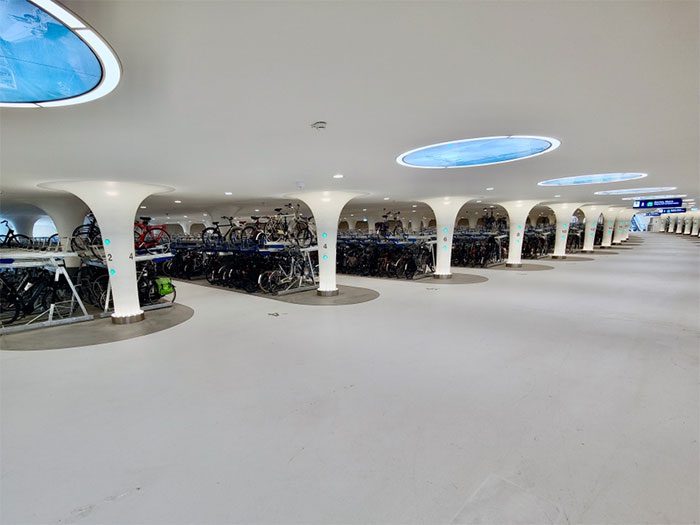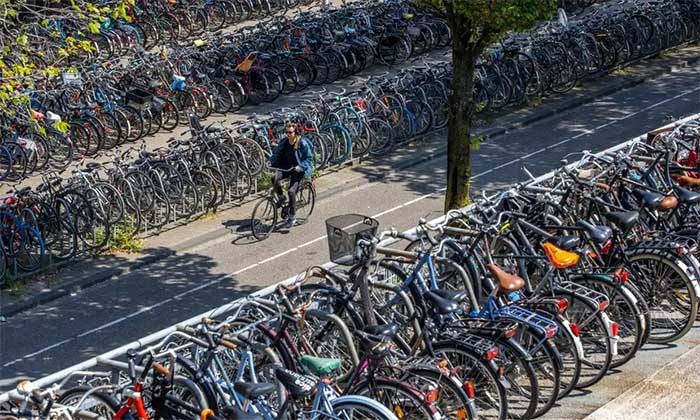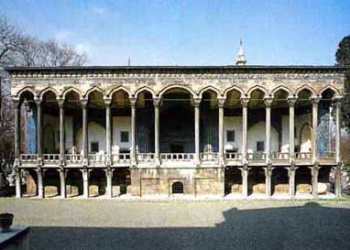The unique underwater bicycle parking project began construction in 2019 and has officially become operational, effectively addressing the cluttered landscape of Amsterdam, Netherlands.
Next to Amsterdam Central Station, beneath the clear waters and the familiar cruise ships, stands an impressive public structure: an underwater parking facility for 7,000 bicycles.
A Model of Success
After four years of construction, the 63 million EUR underwater bicycle parking facility was inaugurated on January 26. This space collects old, rusty bicycles left by passersby while also providing a civilized and safe parking area underground. Bicycles can be parked free of charge for the first 24 hours, with a fee of 1.35 EUR for each additional 24-hour period thereafter.

Underground underwater bicycle parking next to Amsterdam Central Station, Netherlands. (Photo: The Verge).
The underwater parking facility is connected to the train station via a small pathway, accommodating over 200,000 visitors daily. Adjacent to the IJ harbor is another new parking area worth 25 million EUR, which can hold 4,000 bicycles, just a few meters from the North-South metro line.
The construction project for the underwater bicycle parking began in 2019, requiring the draining of a lake next to the historic station built in the late 19th century, which itself was constructed on three artificial islands.
Pieter Visser, the project manager for cycling in the city of Amsterdam, stated: “Amsterdam Central Station is one of the busiest places in the city. Many cyclists use this public space to ride and park their bicycles. The city has implemented underground bicycle parking to free up space for pedestrians, tourists, and people with disabilities.”
According to BOVAG and RAI, the number of bicycles in this small country exceeds its current population, with estimates showing about 23.4 million bicycles compared to the Netherlands’ population of 17.8 million people. The latest figures indicate that 835,000 Amsterdam residents make an average of 665,000 cycling trips daily; 36% of these trips are by bicycle (compared to 24% by car).
Connecting Bicycle Parking to the Station
For rail transport, this project makes commuting easier and more attractive. Jeroen Wienen, spokesperson for ProRail, the Dutch government organization responsible for maintaining and expanding the national railway infrastructure, commented: “It’s wonderful that people can cycle, arrive at the station, and easily start their journey.”
“The Netherlands is a bicycle-friendly country, with many people reaching the station by bike, so we and the city authorities do not want those bicycles scattered everywhere. We aim to create a safe place for residents to park, enhancing the street landscape and surrounding areas.”

The Netherlands is a bicycle-friendly country. (Photo: Alamy).
Both professional cyclists and Amsterdam residents have welcomed the initiative as the riverbanks of the city have been cleared. Marco te Brömmelstroet, a self-proclaimed “bicycle expert” and director of the Urban Cycling Institute at the University of Amsterdam, noted that the key to the project’s success lies in the integration of different modes of transport.
“This is an excellent project, and the key factor for success is the spatial policy and mobility of the Netherlands: the combination of bicycles and trains. Previously, cyclists had to park in temporary, cluttered multi-storey bike racks, which did not contribute positively to the overall landscape.”
Lucas Sanije, Director of Research and Policy Advocacy at the cycling advocacy organization BYCS, pointed out that other countries can learn from providing appropriate facilities at stations to encourage cycling.
He stated: “Bicycles are a friendly mode of transport that can make cities more harmonious while also fostering community spirit, trust, and well-being.”
However, Marco te Brömmelstroet highlighted that even this 85 million EUR investment in bicycle infrastructure is quite small compared to the projects designated for the 9 million cars in the Netherlands.
Walther Ploos van Amstel, a professor of urban logistics at the Amsterdam University of Applied Sciences, noted that cities thrive and become safer and more vibrant when they encourage walking.





















































